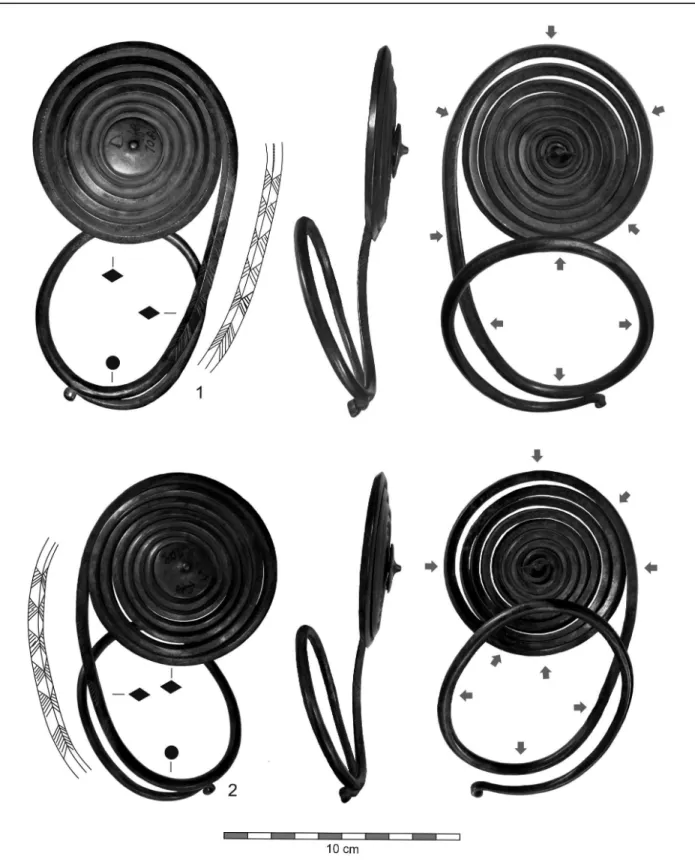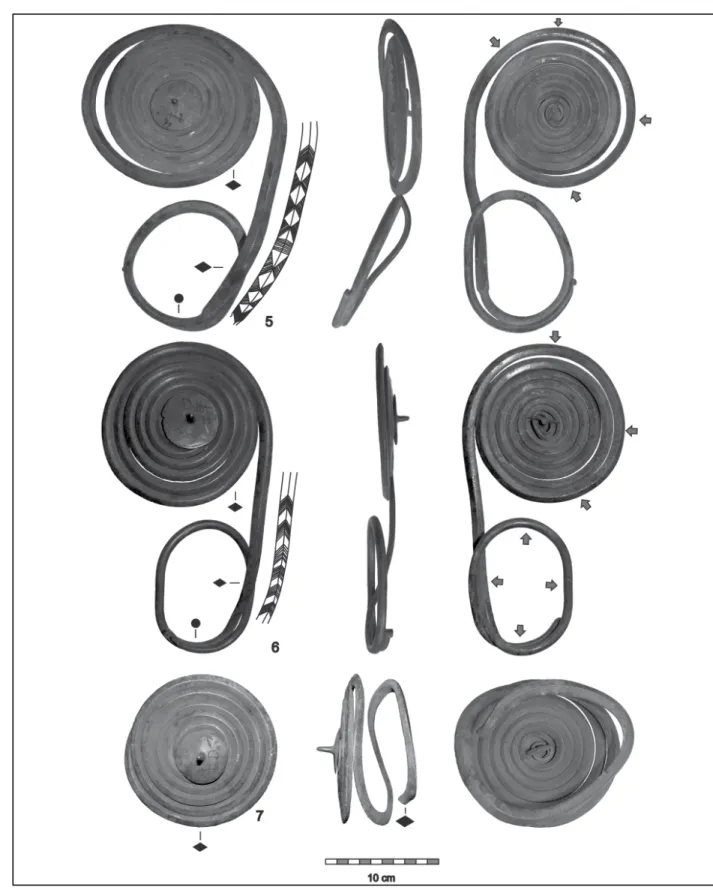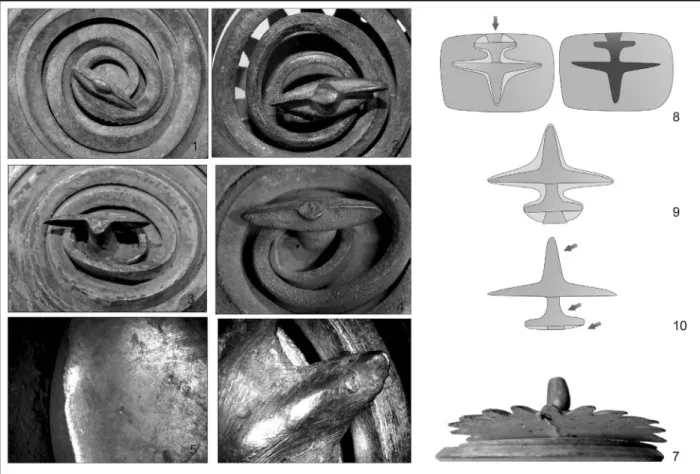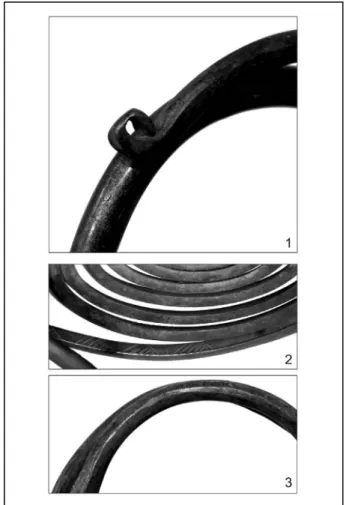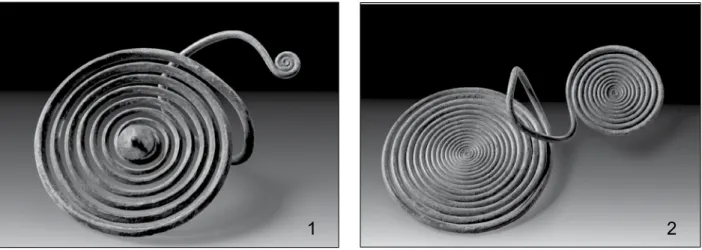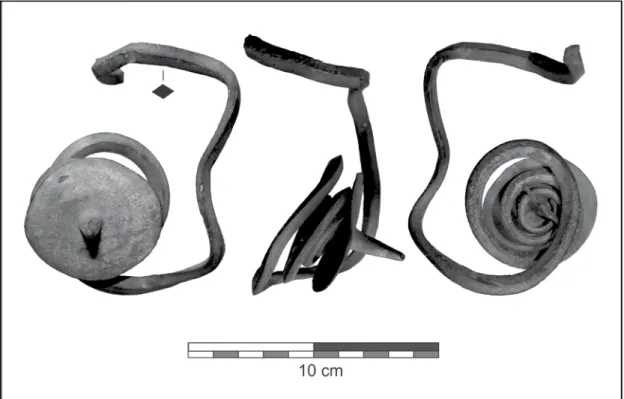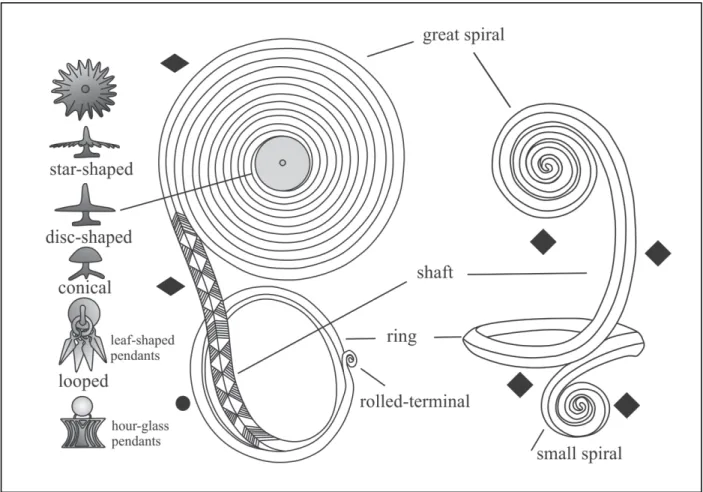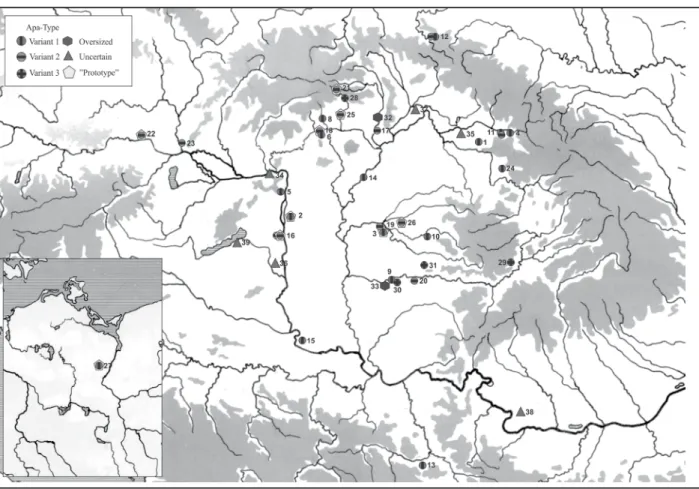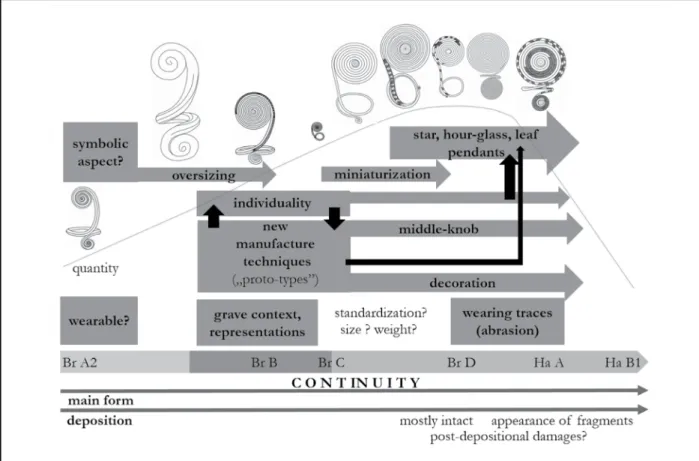J. Gábor Tarbay
THE CENTRAL-EUROPEAN “SPIRAL ARM-GUARD”
NOTES ON THE BRONZE AGE ASYMMETRICAL ARM- AND ANKLETS
The aim of this study is to evaluate seven, unpublished Late Bronze Age (Br D–Ha A1) “spiral arm-guards”
(Germ. Handschutzspiralen) from the Delhaes collection (Hungarian National Museum, Budapest). Despite the fact that their exact finding place and circumstances of discovery are unknown, it was possible to locate their presumable place of origin by the aid of the typo-chronological method. Moreover, with the help of macroscopic observations, we could provide new data and questions on the possible manufacturing tech- niques and usage of this important jewelry group. In relation to the above, it was necessary to offer a new overview on the typo-chronological aspects and functional questions of the earlier published artefacts from the Br A2 to the Ha B1.
Jelen tanulmány célja, hogy a Delhaes gyűjtemény (Magyar Nemzeti Múzeum, Budapest) hét, eddig közöletlen, késő bronzkori (Br D–Ha A1) “kézvédő tekercsét” vegye vizsgálat alá. Annak ellenére, hogy a tárgyak lelőhelye és pontos előkerülési körülményei ismeretlenek, a tipokronológiai elemzés alapján meg- tudtuk határozni lehetséges készítési területüket, továbbá a makroszkópikus megfigyelések segítségével új adatokkal tudtunk szolgálni ezen jelentős ékszercsoport lehetséges készítéstechnológiájáról és használa- táról. Mindehhez kapcsolódóan elkerülhetetlen feladat volt, hogy egy újabb áttekintést adjunk a korábban már közölt Br A2 és Ha B1 közé keltezhető tárgyak tipokronológiai és funkcionális kérdéseiről.
Keywords: collection of István Delhaes, Bronze Age Carpathian Basin, defensive weapon, wearable jew- elries, symbolic objects
Kulcsszavak: Delhaes István gyűjteménye, bronzkori Kárpát-medence, védőfegyverek, hordható ékszerek, szimbolikus tárgyak
Introduction1
The analyzed “spiral arm-guards” were originally part of the collection of the famous painter and col- lector: István Delhaes (1843–1901). After his death, this vast collection was split into parts and was acquired by many different museums. A significant part of his prehistoric collection – which included approximately 208 bronze, stone and ceramic arte- facts from the Neolithic to the Late Iron Age – was donated to the Hungarian National Museum (Buda- pest), in 11. January 1902 (Pallos 2002, 243–244;
Pallos–Kemenczei 2002, 38). Although some objects were published earlier by Amália Mozsolics and Tibor Kemenczei, the whole prehistoric collec- tion had never been presented to the archaeological community (mozsolics 1967, Taf. 35, 6–8, Taf. 64,
1a–c; Kemenczei 1988, 53–56, Taf. 30, 280). The main objective of this study is to evaluate the seven
“spiral arm-guards” of the collection from typo- chronological and technological point of view, as accurately as it is possible on the current level of the research.
Unfortunately, the analyzed objects’ exact finding place and circumstances of discovery are unknown. Therefore, they should be interpreted and analyzed as stray finds. However, the possibility should not be excluded that they could have been originally buried together, due to their dating (Br D–Ha A1) and their identical types and because of the deposition of similar objects within one assem- blage in high quantity is also known (e. g. Aiud – 14 pcs) (Petrescu-Dîmboviţa 1998, 32–33). Further- more, the collection contains additional objects with
Fig. 1 Asymmetrical arm-and anklets from the Delhaes collection (Hungarian National Museum):
No. 1–2 (arrows: abrasion traces)
1. kép Asszimetrikus kar-és lábperecek a Delhaes gyűjteményből (Magyar Nemzeti Múzeum):
1–2. sz. (nyilak: kopásnyomok) similar dating – for instance rings with geometrical
decorations, spiral-headed rings, Kemecse-Type pendant and symmetrical armlet etc. –, which might indicate that the objects in question could have been a part of one or more Br D–Ha A1 depots with mixed composition. In any case, these assumptions can no longer be proven due to the lack of documen- tation of the context.
Description (Fig. 12)
It is a well-known phenomenon that during the Bronze Age the “spiral arm guards” appeared in one or more pairs within one assemblage. Based on their dimensions, decorations and the shape of their mid- dle-knobs, it is possible to hypothesize such grouping within the analyzed seven artefacts.2 Consequently, pair I. is composed of the two smaller ones (length:
15,6 cm and 13,9 cm) with cross-hatched triangle patterns and spiny disc-shaped middle-knobs (No.
1–2, Fig. 1, 1–2). The larger examples (length: 27 and 23,6 cm) are also decorated with bundles of lines and can be sorted into pair II. In this case, however, they are equipped with spiny star-shaped middle- knobs (No. 3–4, Fig. 2, 3–4). Regardless of the fact that their dimensions and middle-knobs are nearly the same, No. 5 and No. 6 have different types of decorations (No. 5–6, Fig. 3, 5–6).3
No. 1. The ring part of the object is round-sectioned, the shaft and the great spiral are rhomboid-sectioned. Ham- mering traces can be detected on the ring part and the rolled-terminal of the object. The geometric decoration of the shaft is composed of bundles of slant lines and antithetic, hatched triangles. It is important to note that the above decoration is slightly imprecise. The pattern along the outer coil of the great spiral is composed of fine punched lines. Well-identifiable polishing traces can be observed on the whole surface of the great-spiral and the frontal part of the spiny disc-shaped middle-knob.
However, the lower side of the latter is less worked, due to unpolished casting seams are still visible on it’s sur- face. It is worth to note that incisions can be observed along the center of the great spiral’s inner part. In addi- tion, abrasion traces are visible on the ring part and the outer coil of the great spiral. Length: 15,6 cm, thickness (lower): 0,5 cm x 0,5 cm, thickness (upper): 0,6 x 0,4 cm, width (lower): 7,9 cm, width (upper): 8,6 cm, diameter of the lower section: 6,7 cm x 8,2 cm, diameter of the casted middle-knob: 2,4 cm, width of the narrow side: 4,5 cm, outstretched length: 162,2 cm, weight: 205 g (Fig. 1, 1).
No. 2. The ring part of the object is round-sectioned, the shaft and the great spiral are rhomboid-sectioned.
The end of the object is rolled. Hammering traces can
be detected on the ring part and the rolled-terminal of the object. The shaft is decorated with bundles of slant lines and antithetic, hatched triangles. Similarly to No. 1 these patterns are also imprecise. The pattern along the outer coil of the great spiral is composed of fine punched lines. Polishing traces can be observed on the surface of the great spiral and the outer surface of the spiny middle- knob. Unpolished casting seams are visible on the lower side of the middle-knob. Similarly to the other, incisions can be observed along the center of the great spiral’s inner part. The abrasion traces concentrate on the ring part and the outer coil of the great spiral. Length: 13,9 cm, thick- ness (lower): 0,5 cm x 0,5 cm, thickness (upper): 0,6 cm x 0,5 cm, width (lower): 7,4 cm, width (upper): 8,7 cm, diameter of the lower section: 6,5 cm x 7,9 cm, diameter of the casted mid-section: 2,3 cm, width of the narrow side: 5,1 cm, outstretched length: 166,2 cm, weight: 188 g (Fig. 1, 2).
No. 3. The ring part of the object is round-sectioned, the shaft and the great spiral are rhomboid-sectioned.
The end of the ring part is rolled. On the ring part, ham- mering traces are visible. The decoration of the shaft is composed of bundles of slant lines. The outer coil of the great spiral is decorated with fine punched lines. Both the frontal and the lower side of the star-shaped middle-knob are less elaborated. In addition, overflows and horizontal shift are also visible on the lower side. Length: 27 cm, thickness (lower): 0,6 cm x 0,6 cm, thickness (upper):
0,8 cm x 0,6 cm, width (lower): 8 cm, width (upper):
11,7 cm, diameter of the lower section: 6,7 cm x 10,1 cm, diameter of the casted mid-section: 4,4 cm, width of the narrow side: 8,1 cm, outstretched length: 240,7 cm, weight: 355 g (Fig. 2, 3).
No. 4. The ring zone is round-sectioned, the shaft and the great spiral are rhomboid-sectioned. The end of the object is rolled. On this part, clear traces of hammering are visible. The shaft is decorated with bundles of slant lines, the outer coil of the great spiral is decorated with fine punched lines. The surface of the great spiral is well- polished. Similarly to the latter the spiny star-shaped middle-knob shows traces of casting faults (e. g. over- flows and horizontal shift) and its outer surface is well- polished. It is important to note that similarly to the No.
1 and No. 2 examples fine incisions are visible along the spine of the great spiral’s inner part. The abrasion traces concentrate on the ring part and the outer coil of the great spiral. Length: 23,6 cm, thickness (lower): 0,6 cm x 0,6 cm, thickness (upper): 9 cm x 0,6 cm, width (lower): 10 cm, width (upper): 14,1 cm, diameter of the lower sec- tion: 8,7 cm x 11 cm, diameter of the casted mid-section:
4,6 cm, width of the narrow side: 5,6 cm, outstretched length: 269,2 cm, weight: 581 g (Fig. 2, 4).
No. 5. Its ring part is round-sectioned but the shaft and the great spiral are rhomboid-sectioned. The end of the
Fig. 3 Asymmetrical arm-and anklets from the Collection of István Delhaes (Hungarian National Museum): No. 5–7 (arrows: abrasion traces)
3. kép Aszimmetrikus kar-és lábperecek a Delhaes gyűjteményből (Magyar Nemzeti Múzeum): 5–7. sz.
(nyilak: kopásnyomok) Fig. 2 Asymmetrical arm-and anklets from the Delhaes collection (Hungarian National Museum): No. 3–4
(arrows: abrasion traces)
2. kép Asszimetrikus kar-és lábperecek a Delhaes gyűjteményből (Magyar Nemzeti Múzeum): 3–4. sz.
(nyilak: kopásnyomok)
tern was applied by a slightly curved edged punch- ing chisel which traces can be well-identified by the creasing of the punched surface (Fig. 5, 1–2). It is not entirely clear that the decoration on the shaft was applied before, after or during the formation of the great spiral. However, the position of the pattern on the No. 2 specimen might exclude the posterior decorating (Fig. 6, 2). In contrast, the decorations on the outer coil can also be created after the forma- tion of the great spiral (Fig. 5, 3).
Perhaps the most uncertain stage is the forma- tion of the great spiral which could be carried out by many different ways. Based on our observations, the first two inner coils were hammered around a rod or the middle-knob (Fig. 4, 1–4). I believe that it is most likely that the middle-knob was applied after the formation of the whole great spiral because the thin inner part of the spiral can easily bended out. This posterior manipulation could provide enough space to put in the middle-knob before clos- ing the inner part of the spiral around it. It should be noted that the punch marks on the inner coil might be associated with the above process (Fig. 4, 1). After manufacturing the first coils the additional parts could have also been manufactured by ham- mering which could be carried out by two differ- ent ways, the so called “shell-” and the “corkscrew”
methods (Blajer 1984, 75, Abb. 3–4). Basically, the difference between the above techniques is how the craftsman presses the conical shaped spiral into disc (Blajer 1984, Abb. 3). According to the corkscrew method, the conical spiral was pressed in a second stage after its manufacturing, while in the case of the shell method the spiral is under a constant pres- sure (Blajer 1984, Abb. 4). However, in case of our analyzed example, hammering traces were not vis- ible at all along the lateral side of the coils of the great spiral, moreover these parts were perfectly angular (e. g. Fig. 7, 3). This observation indicates, that these rectangular great-spirals might be created by annealing and bending. In any case, due to its uncertainties this fabrication stage must be tested by experiments. The next step is the manufacture of the ring part that might have followed the formation of the great spiral, which presumption can be support- ed by the unfinished product from Sălăcea (Bader 1972, Fig. 1). This part partly fastened the object to the wearer’s leg or forearm (emőDi 2011, 186–187, Fig. 2; Kovács 1992, Abb. 62; matić 2010, 147, Sikla 5) was hammered into circular-sectioned form (Fig. 6, 3) and after that its terminal was also rolled by hammering. It should be noted that this forma- tion process share similarities with the manufactur- ing of the torques (vasić 2010, 3–9).
According to the documented burial context and the clay representations, these metal objects were worn primarily on the leg, but the wearing practice on the wrist or forearm should not be excluded either (Kovács 1992, Abb 62; matić 2010, 147, Sikla 5; emőDi 2011, 186–187, Fig. 2).
It is very possible that they were applied to some sort of organic material (presumably to shoes or to an outerwear). According to observations by József Hampel in the 19th century, textile residues were visible on the inner surface of the Cserépfalva find (HamPel 1896a, 188–119). Unfortunately, during our present day investigation, we could not iden- tify any traces of this organic material because its remains were completely destroyed by earlier res- toration. Noteworthy, that the existence of organic part could explain the frequent application of the middle-knobs which could stabilize the fastening.
In association with the usage, interesting observa- tions can be made on specimens from the Delhaes collection. On five of the seven specimens (No.
1–2, No. 4–6) intensive traces of abrasion were visible along the ring part and along the outer coil of the great spiral, especially on the inner surface (Fig. 1, 1–2, Fig. 2, 4, Fig. 3, 5–6). Hollow abra- sions are visible sometimes on the inner part of the great spiral caused by rubbing against the middle- knob (Fig. 7, 7). Similar effect could cause the polishing of the shaft of the middle-knobs (Fig. 4, 1–4, Fig. 7, 7). Although it should not be excluded that these abrasions can be associated with post- depositional processes, I believe their intensity could support their prehistoric origin. By all means, experimentation could prove what kinds of use and materials (e. g. textile, leather, human skin) could cause similar phenomenons. This might also solve an essential question: the question of ceremonial or everyday use. Last but not least, during the exami- nation of the artefacts we paid special attention to the detection of weapon impacts. In contrast to Kris- tian Kristiansen’s analysis, no traces of such impact were visible on the analyzed objects (Kristiansen 2002, 326; molloy 2009, Fig. 4–5). Therefore, we cannot support the defensive weapon theory.
In this section, our goal was to investigate the manufacture techniques and possible usage of the collection’s artefacts by aid of the macroscopic observations. Based on these results, a very inter- esting, complex chaîne opératoire can be outlined.
However, as it was already emphasized, these results should be tested by experimentations based on archaeometrical analysis (e. g. TOF-ND and EPMA).
object is rolled. On the ring part hammering traces are visible. The pattern of the shaft is composed of antitheti- cal, hatched triangles and parallel bundles of lines. The pattern along the outer coil of the great spiral is com- posed of fine punched lines. Polishing is visible on the great spiral and the outer surface of the disc-shaped middle-knob. It is important to note that casting faults were visible on the back side of the middle-knob. Inci- sions were detected on the inner part of the great spi- ral. The abrasion traces concentrate on the outer coil of the great spiral. Length: 27,1 cm, thickness (lower): 0,9 cm x 0,8 cm, thickness (upper): 1,2 cm x 0,7 cm, width (lower): 10,1 cm, width (upper): 16,6 cm, diameter of the lower section: 11,1 cm x 8,5 cm, diameter of the casted mid-section: 4,3 cm, width of the narrow side: 9,9 cm, outstretched length: 288,7 cm, weight: 864 g (Fig. 3, 5).
No. 6. The ring part of the object is round-, the shaft and the great spiral are rhomboid-sectioned. The ring part is rolled, hammering can be observed on this part. The geo- metric decoration of the shaft is composed of bundles of slant lines. The pattern along the outer coil of the great spiral is composed of fine punched lines. The great spiral and the outer surface of the spiny disc-like middle-knob are well-polished. Abrasion traces concentrate on the outer coil of the great spiral. Length: 27, 5 cm, thick- ness (lower): 0,8 cm x 0,8 cm, thickness (upper): 1 cm x 0,6 cm, width (lower): 9,1 cm, width (upper): 14,4 cm, diameter of the lower section: 10,7 cm x 7,7 cm, diameter of the casted mid-section: 4,6 cm, width of the narrow side: 5,3 cm, outstretched length: 252,2 cm, weight: 704 g (Fig. 3, 6).
No. 7. The remaining part of the shaft and the great spiral are rhomboid-sectioned. Fine punching can be observed on the spine of the shaft. The outer part of the middle-knob and the great spiral are well-polished. Slight horizontal shift can be seen on the back side of the middle-knob. The pattern along the outer coil of the great spiral is composed of fine punched lines. Length: 13,5 cm, thickness: 1,2 cm x 0,6 cm, width: 13 cm, diameter of the casted mid-section:
4,2 cm, width of the narrow side: 9,5 cm, outstretched length: 223,4 cm, weight: 623 g (Fig. 3, 7).
The results of the macroscopic observations
Within the following brief subsection, we would like to raise a few questions and outline possibilities on the manufacturing techniques and usage of the analyzed specimens from the Delhaes collection.
The presented presumptions are primarily rested on our macroscopic observations,4 discussions with experts and colleagues5 and the data from archae- ological literature (Blajer 1984, 73–77). We are aware of the evident fact that these objects could have been manufactured and used by many different
ways, therefore the below described results cannot ultimately answer the question of manufacturing; this paper is rather an attempt to understand these objects better on our current level of knowledge. In order to give a more complex – scientifically adequate – answer to the questions of how it was made and how it was used, further experimentations with different kinds of methods and archaeometrical analyses are essential in the future (e. g. Kissetal 2015).
My assumption is that the production of compa- rable objects such as the specimens of the Delhaes collection can be divided into two main parts. One of them is the casting of the middle-knob (Fig. 4).
The clear traces of this manufacturing method can be easily detected on the backside of the middle- knobs where less polished casting seams (Fig. 4, 2, 4, 7), the remain of the broken casting jet (Fig. 4, 1–4) and even minor casting faults such as verti- cal shifts of the casted sides6 are visible (Fig. 4, 2).
The above observations refer to the possibility that these parts were casted in bivalve moulds (Fig. 4, 8). (Unfortunately, we are not aware of such mid- dle-knob moulds from the archaeological record.) After casting, the freshly made middle-knob logi- cally went through different stages of fabrications which include the removal of the casting jet and casting seams and finally polishing the minor cast- ing faults and the outer surface of the object (Fig. 4, 5–6, 9–10).
The other step of production – the manufac- ture of the object’s body – is less clear, and in my point of view without experimentations it cannot be answered precisely. Therefore, the below suspected sequence of the different sub-stages are also not entirely certain. However, it is probable that this step started with the casting of a thick rod ingot which was later stretched by annealing and ham- mering into the required size. The following step could be the formation of the cross-sections. Both end of the rod was hammered into thin and rectan- gular shape. One of them later became the center of the great spiral (Fig. 4, 1–4), the other served as the rolled-terminal of the object (Fig. 6, 1). The main part which later served as the great spiral and the shaft were hammered into rhomboid-sectioned probably on a special ambos (e. g. Tállya-Várhegy) (v. szaBó 2013, 812, Fig. 18). After this process, the surface of this area was polished (Fig. 5, 4). Accord- ing to the dimensions of the analyzed specimens from the Delhaes collection, the length of the rod before the formation of the great spiral could have varied approximately7 between 162,2 cm (No. 1) to 288,7 cm (No. 5). In relation to the decorations, the macroscopic observations support that the pat-
thoughts of Childe, the Slovakian research often called attention to the similarities and connections between the star-shaped middle-knob of the one from Švedlar and the breast part of the Čaka armour (PaulíK 1963, 51, Abb. 7C.1; novotná 1970a, 39;
novotná 1970B, 39, Taf. 56, 13). Later, on the basis of the uncomfortable wearing, this idea was rightly criticized by Tibor Kemenczei (Kemenczei 1964–1965, 113). Even though, in her earlier works, Amália Mozsolics classified them into the group of jewellery (mozsolics 1967, 73–75; mozsolics 1973, 62–63). In 1985, she sorted these objects into the group of defensive armours and suggested that they could have been worn on the upper arm and served as knee-protective armour (mozsolics 1985, 29). Later, the defensive weapon theory was sup- ported again by Kristian Kristiansen who stated that the smaller versions protected the hand and the greater ones covered the upper arms and the elbow.
His theory seemed to be confirmed by the object forms, dimensions and the well-known fact that they often combine with other offensive- (e. g. swords, lances) and possible defensive weapons (PoPescu 1937–1940, 122; scHumacHer-mättHaus 1985, Tab. 91–95; Hansen 1994, 278; Kristiansen 2002, 326). In contrast to this, Gisela Schumacher-Mät- thaus formulated a rather sceptic opinion and inter- preted these objects as arm jewellery (scHumacHer- mättHaus 1985, 119, Taf. 68, 2a–3a, Taf. 69, 2a, 4a, Taf. 72, 1a–2a, Taf. 74, 2a–5a, Taf. 77, 2a–5a).
She also drew attention to the fact that although they often combine with weapons, their appearance with woman jewelry can also be observed. Moreo- ver, in the case of the smaller examples – such as our No. 1 and No. 2 (Fig. 1, 2–3) –, it should not be excluded that they could have been worn by children (scHumacHer-mättHaus 1985, 119–120, Tab. 91–95). As Wojciech Blajer has pointed out, Fig. 5 Macroscopic observations. 1: the punched decoration of the shaft (No. 3); 2: “Imprecise” punched decoration on the shaft (No. 2); 3: punched decoration on the outer coil of the great spiral (No. 6); 4: polishing traces on the great
spiral (No. 2)
5. kép Makroszkópikus megfigyelések. 1: poncolt díszítés a száron (3. sz.); 2: “pontatlan” poncolt díszítés a száron (2. sz.); 3: poncolt díszítés a nagyspirál külső menetén (6. sz.); 4: polírozás nyomok a nagyspirálon (2. sz.)
Too heavy armour?
The so called “spiral arm-guards”, commonly known as Handschutzspiralen (Germ.) have been evaluated since the 19th century. During this long research, these objects occurred under several dif- ferent Hungarian8, German9, English10, French11 and other names (KuBínyi 1861, 87; rómer 1866, 53; HamPel 1881, 277; HamPel 1886B, 74; HamPel 1886c, 14; HamPel 1890, 148; cHilde 1929, 274;
PoPescu 1937–1940, 122; nestor 1938, 190; Patay 1954, 46; Foltiny 1955, 31; HacHmann 1957, 92; Kemenczei 1962–1963, 15; jósa–Kemenczei 1965, X. T.; Patay 1966, 81; von Brunn 1968, 33;
Kemenczei 1969, 29; novotná 1970a, 27; Brownet
al. 1987, 94; Petrescu-Dîmboviţa 1998, 29; Hel-
leBrandt 1999, 140; Kristiansen 2002, 326–327).
This confusing terminology – which is not an uncommon methodological problem today – basi-
cally can be associated with these objects’ function- al interpretations.
The very first who sorted them into the group of defensive weapons was Flóris Rómer (rómer 1866, 53). Later, his concept was adopted by József Hampel despite that Rómer emphasized the uncer- tainties of this idea (HamPel 1886a, 188–119, XXX- VI. T. 4–5, XXXVII. T. 1–2). According to him, these objects protected the back of hand and prob- able used together by the reason of that “left- and right-handed” pieces are often combined within one assemblage. On the basis of the textile residue on the inner surface of the specimen from Cserépfalva, he suspected that these objects could have originally some sort of felt or other organic part which was fas- tened by the aid of a middle-knob (HamPel 1896a, 118–119; vacHta 2007, 37). Another concept was that they were slipped through the arms and covered the breasts (cHilde 1929, 274). Following the above Fig. 4 Macroscopic observations. 1–4: the lower side of the middle-knobs (No. 4–7); 5–6: polishing traces on the outer surface of the middle-knobs (No. 3, No. 7); 7: casting seam on the lower side of the No. 3 specimen’s middle-knob;
8–10: the steps of middle-knob casting
4. kép Makroszkópikus megfigyelések. 1–4: A középgombok alsó része (4–7. sz.); 5–6: polírozás nyomok a középgom- bok külső felületén (3–7. sz.); 7: öntési varratok a 3. sz. példány középgombjának also részén; 8–10: a középgomb
öntésének szakaszai
and anklets. In addition, another part of them could have been sold on auctions or very likely remained hidden in Western European or Hungarian private collections (Fig. 8–11, List 3). Because the quan- tity of the published examples has grown since the 19th century, it is necessary to establish a more detailed typological scheme. As a consequence, many prominent studies attempted to analyze these objects’ chronological and typological features (nestor 1938, 178; Foltiny 1955, 31–32; Kemenc-
zei 1965, 111–113; mozsolics 1967, 73–75; Hänsel 1968a, 102–104; novotná 1970a, 39–40; Bader 1972, 92–94; mozsolics 1973, 62–63; FurmáneK 1977, 275–276; Blajer 1984, 65–69; mozsolics 1985, 29; scHumacHer-mättHaus 1985, 119–120;
Kacsó 1997–1998, 14; KoBal’ 1997–1998, 38–39;
Petrescu-Dîmboviţa 1998, 35–36; Kobal’ 2000, 29–30; vacHta 2007, 37). Following the same typo- logical method, these works took under examina-
tion the objects’ fine features such as the decora- tions, middle-knob types, cross-sections and termi- nals (Fig. 12). Apart from their different grouping, these works’ common characteristic is the distinct separation of the older ones (Early/Middle Bronze Age) from the younger Late Bronze Age specimens (Table 1). In spite of their prominent results, as Josip V. Kobal’ has earlier pointed out, some typological problems and contradictions still remain unsolved (KoBal’ 1997–1998, 38–39). Therefore, to evalu- ate and interpret the Delhaes collection’s seven asymmetrical arm-and anklets on our current level of knowledge, it is necessary to overview and re- build the typology of this artefact group. As a con- sequence, a new typological model of the asymmet- rical arm-and anklets will be presented below. The principles of grouping and terminology partly fol- low and rely on the above cited fundamental works.
The main goal of this classification is not to give Fig. 7 Macroscopic observations. 1: abrasion on the ring part of the No. 8 specimen; 2–6: abrasion on the outer coils of the great spiral (No. 2, No. 4–5); 7: abrasion on the inner coil of the great spiral (No. 6); 8: the concentration of wearing
traces on the analyzed objects
7. kép Makroszkópikus megfigyelések. 1: kopásnyom a 8. sz példány gyűrű részén; 2–6: kopásnyom a nagyspirál külső részén (2. és 4–5. sz.); 7: kopásnyom a nagyspirál belső részén (6. sz.); 8: a használati nyomok sűrűsödése az elemzett
tárgyakon
her last suggestions are not necessarily true because the smaller examples could have been worn on slen- derer body parts (e. g. wrist) as well (Blajer 1984, 79). The recent ideas of Tillman Vachta should be emphasized who stated that the weight of these objects simply made them ineffective during a fight, therefore they can rather be interpreted as a spe- cial type of jewelry or symbolic object which lost their primary and “utilitarian” function during their long period of developing (vacHta 2007, 38–39).
His suggestions can be supported by the fact that the classical defensive amours between the Ha A and Ha B stages are composed of relatively light, flexible metal sheets riveted onto organic materials.
None of these above mentioned features are charac-
teristic to the “spiral arm-guards” which structure is rigid and their weight is too heavy to allow fast movements during a real combat (e. g. No. 5: 864 g, No. 6: 704 g, Fig. 3, 5–6). Based on the above considerations and the results of our macroscopic observations, it is highly unlikely that these objects could have served as defensive weapons.
To conclude, the whole functional and termino- logical problem is rooted in the fact that the known
“spiral arm-guards” were mostly unearthed as part of hoards, therefore our knowledge is very limited about their exact wearing practices. For instance, in the case of the Late Bronze Age ones we can only rely on macroscopic observations such as our pre- sent analysis which seems to support their wearing practice. However, the Tiszafüred-Majoroshalom grave and the miniature examples from Piliny culture’s burials (e. g. Bátonyterenye, Piliny) are seen to be exceptions (HamPel 1886a, LXX. T. 9;
Patay 1954, 42, 46, Abb. 17, 4–5; Hänsel 1968a, 102; scHumacHer-mättHaus 1985, 119; david 2002a, 473; david 2002B, Taf. 261A, 4). In the case of Tiszafüred, the object in question was pulled through the deceased’s leg (Kovács 1991–1992, 29;
Kovács 1992, Abb. 62). In connection with the lat- ter, an interesting artefact group was published by János Emődi. On the clay leg representations from Valea Iui Mihai, Oradea and Marghita these objects were positioned on the ankle (emőDi 2011, 186–
187, Fig. 2). Nevertheless, other sources such as the representations of anthropomorphic idols (e. g.
Dupljaja) indicate that the older form of the “spiral arm-guards” have been worn on the forearm (matić 2010, 147, Sikla 5; vacHta 2007, 38). Consequent- ly, it is likely that the analyzed objects – especially the older ones – could have been served as some sort of anklets or armlets, comparable to the symmetri- cal variants of this jewelry group12 (ricHter 1970, 41; blajer 1984, 16–64; Petrescu-Dîmboviţa 1998, 37–39). Based on the above, in the present study we shall follow the terminology of Wojciech Blajer and Milan Salaš and name these objects as asymmetri- cal arm-and anklets (Blajer 1984, 2, Abb. 1; salaš 1997, 93–94).
A typological model of the asymmetrical arm-and anklets of Central Europe
After József Hampel’s classical work, several new artefacts have come to light from all across the Car- pathian Basin (HamPel 1896a, 118–119). Most of them have been published; however it is also pos- sible that some fragmented or less characteristic examples were not evaluated as asymmetrical arm- Fig. 6 Macroscopic observations. 1: hammering traces on
the rolled-terminal of No. 2 specimen; 2: the position of the decoration on the object No. 2; 3: hammering traces
on the ring part of the object No. 4
6. kép Makroszkópikus megfigyelések. 1: kalapálás nyomok a 2. példány visszapödrött végén; 2: a díszítés
helyzete a 2. sz. tárgyon; 3: kalapálás nyomok a 4. sz.
darab gyűrű részén
Fig. 8 Asymmetrical arm-and anklets from the auction of the Gorny&Mosch (List 3, 1–2) 8. kép Aszimmetrikus kar-és lábperecek a Gorny&Mosch aukciójáról (3.lista 1–2)
Fig. 9 Asymmetrical arm-and anklets from Western European auctions (List 3, 3–6) 9. kép Aszimmetrikus kar-és lábperecek nyugat-európai aukciókról (3.lista 3–6)
1 2
Table 1 The most influential typological schemes of the asymmetrical arm-and anklets 1. táblázat Az asszimetrikus kar-és lábperecek legjelentősebb tipológiai csoportjai
13, 3, Pl. 20, 5). Nevertheless, most of the known specimens belong to the Br B stage. Dominant part of them are individual or stray finds or were found in depots, only two specimens are known from burial context (Tiszafüred-Majoroshalom, Hernádkak) (točiK–buDinsKý-KričKa 1987, Abb.
8; Kovács 1992, Abb. 62) (List 1). Their common characteristic is that all of them have a great and a small spiral and except from the “prototypes” of the Late Bronze Age ones they are undecorated. As regards their dimensions, smaller and greater ones can be equally found among them. It is important to note that the phenomenon of oversizing (e. g.
Abaújdevecser, Vinga) is only characteristic to this type (Petrescu-Dîmboviţa 1998, 32, Taf. 16, 120;
HelleBrandt 2011, 133, 3–5. kép). Following the footsteps of Carol Kacsó, it is possible to sort them into three variants: variant 1 (angular-sectioned), variant 2 (angular-sectioned with round-sectioned ring part), variant 3 (round-sectioned) (Kacsó 1997–1998, 14). However, it should be emphasized that the distribution and dating of these variants strongly overlap. In addition, it is not uncommon that they combine within one assemblage (e. g.
Săpănţa, Stefkowa) (Blajer 1984, 65–67, Taf. 65, 213; soroceanu 2012, 97, Taf. 29, 3–4) (Fig. 12).
As regards their chronology, the 1st and 2nd variants
appeared together in the Br A2, however, they show dominance in Br B depots along with the 3rd vari- ant. It is important to note that later deposition (e.
g. Br D – Rimavská Sobota 2) of the 1st variant was also documented (PaulíK 1965, Taf. 2, 1–2). The so called “prototpyes” which have first appeared in the Br B (Fig. 14) are essential from typological point of view. These objects can be well-sorted into the Apa-Type, however, some of their features can be related to the Late Bronze Age specimens (Kemenc-
zei 1965, 111). Most of them are decorated on their shaft, great spiral or ring parts (e. g. Angermünde, Hodejov 2, Spišský Štvrtok, Stockerau, Včelince, Zsadány) and in some cases they are equipped with middle-knobs (e. g. Békés, Dunaújváros-Koszider- padlás 3, Pusztaszentkirály) just as we can see in the case of the Late Bronze Age ones (BoHm 1935, Taf. 15; angeli 1961, 141, Taf. 8, 3–4; novotná 1966, Taf. 8; mozsolics 1967, 135–136, 153–154, 156, Taf. 52, 5, Taf. 63, 1–2, Taf. 69, 1–3; FurmáneK 1977, 258, Taf. XXXII, 8, 13; szatmári 1998, 117–
118, 19. T. 5, 7; FurmáneK 2004, 73) (Fig. 13). Their distribution shows no specific concentration. How- ever, these specimens appear in relatively greater number in the territory of the North-Eastern Car- pathian Basin which later became the main distribu- tion area of the Late Bronze Age Salgótarján-Type.
Fig. 11 A Salgótarján-Type fragment from the private collection of Zoltán Repkényi (List 3, 11) 11. kép Salgótarján típusú töredék Repkényi Zoltán magángyűjteményéből (3.lista 11) an over-detailed grouping with countless of sub-
variants and combination types but rather build an easily analyzable, spatially and chronologically rel- evant scheme. It is important to emphasize that this model cannot be perfect without the re-examination of the published artefacts which extends beyond the aim of the current study.13
The group of asymmetrical arm-and anklets has appeared in the Br A2 and shows dominance in the Br B. However, the highlight of their deposi- tion can be dated to the Br D–Ha A1 stages after which only few specimens are known (Foltiny 1955, 31–32; Bóna 1959, 238; Kemenczei 1962–
1963, 15; Kemenczei 1964–1965, 50, 53; Kemenc-
zei 1965, 111–112; Patay 1966, 81; Hänsel 1968a, 103; novotná 1970a, 26; Blajer 1984, 68–69;
mozsolics 1985, 29; scHmucHer-mättHaus 1985, 119; Petrescu-Dîmboviţa 1998, 35; vacHta 2007, 37; tótH 2010, 64–65) (Fig. 14). During this long period of deposition, they primarily distribute over the Eastern part of the Carpathian Basin. However, they are also known – sporadically – from Trans-
danubia, the Balkan Peninsula and the territory of South-Eastern Bohemia, Austria and even from Northern Europe (Fig. 15–16). As it was mentioned earlier, their appearance could have been associated with the group of symmetrical arm-and anklets, but as Waldtraut Bohm pointed out the asymmetrical ones are possibly Carpathian developments (BoHm 1935, 63). From typological point of view, the older examples (Br A2–B) can be sorted into the Apa- Type (variant 1–3) which includes oversized exam- ples and prototypes of the Late Bronze Age ones.
The later, more individualistic examples (Br C–B1) include miniature specimens. In my estimation, they can be sorted into four main types and one hybrid- type: Salgótarján-Type, Kriva-Type, Sântana-Type, Chomonyn-Type and Nyírszőlős-Hybrid Type (Fig.
13).
The earlier forms (Apa-Type) of the asymmet- rical arm-and anklets have appeared first in the Br A2, in Transylvania (e. g. Apa, Păuliş, Valea Chio- arului) (baDer 1972, 92; Petrescu-Dîmboviţa 1998, 31, Taf. 13, 104; soroceanu 2012, 39, 69–70, Pl.
Fig. 10 Asymmetrical arm-and anklets from Western European auctions (List 3, 7–10) 10. kép Aszimmetrikus kar-és lábperecek nyugat-európai aukciókról (3. lista 7–10)
the territory of Bohemia, Austria, Western Hungary, the Northern Balkan and even from South-Western Poland (e. g. Załęże) and in the Ukrainian Dniester region (e. g. Hrushka) (ŻurowsKi 1949, 159–161;
Kemenczei 1965, 111–112; Hänsel 1968B, Karte 22; Bader 1972, 93–94; Blajer 1984, 68, Taf. 80;
mozsolics 1985, 29) (Fig. 16).
Regarding to their typology, the specimens of the Delhaes collection can be sorted into the above discussed type and they can dated between the Br C–Ha A1 stages. Based on their cross-hatched (group I: No. 1–2, 5, Fig. 1, 1–2, Fig. 3, 5) and bun- dles of lines (group II: No. 3–4, 6, Fig. 2, 3–4, Fig.
3, 6) decorations it is also possible to link them to certain examples: group I (List 2. 1. 5, 6, 10, 12, 20, 23, 26, 28, 32, 34, 42, 45, 47, 53, 55), group II (List 2.1. 7, 10, 11, 16, 20, 22, 24, 25, 30, 33, 35, 37, 41, 42, 43, 48, 54). Both decoration groups
concentrate on the main distribution area of this type, however certain examples of the first group have appeared in Transcarpathia (e. g. Volovec), Middle-Slovakia (e. g. Zvolen) and the Southern regions of the Carpathian Basin (e. g. Otok-Priv- laka, Topolnica) (Holste 1951, Taf. 5, 36; Fur-
máneK 1980, Taf. 40, 1–2; Harding 1995, Taf. 58, 5; KoBal’ 2000, Taf. 12, 1). It is also important to draw attention to the star-shaped middle-knob of the No. 3 and No. 4 examples which was only doc- umented in the case of Švedlar and Mezőnyárád (novotná 1970B, Taf. 56, 13; HelleBrandt 1999, 7. kép 1–2). To conclude, based on their fine sty- listic and formal parallels the analyzed objects of the Delhaes collection could have been originated – or at least manufactured – in the core distribution area of the Salgótarján-Type: in the North-Eastern Carpathian Basin (Fig. 16).
Fig. 13 The typology of the asymmetrical arm-and anklets (HamPel 1886A, XXXII. T. 1–2, LXX T. 9; BoHm 1935, 114, Taf. 15; angeli 1961, Taf. 8, 4; mozsolics 1967, Abb. 20, Taf. 69, 2, Taf. 52, 5; garašanin 1972, Cat Nr. 137; Fur-
máneK 1977, Taf. XXXII, 13; Blajer 1984, Taf. 66, 215; Petrescu-Dîmboviţa 1998, Taf. 21, 160a.c; szatmári 1998, 19.
T. 5; KoBal’ 2000, Taf. 10, 5; david 2002B, 492, Taf. 171.10; FurmáneK 2004, 73; HelleBrandt 2011, 3. kép) 13. kép Az aszimmetrikus kar-és lábperecek tipológiája (HamPel 1886A, XXXII. T. 1–2, LXX T. 9; BoHm 1935, 114,
Taf. 15; angeli 1961, Taf. 8, 4; mozsolics 1967, Abb. 20, Taf. 69, 2, Taf. 52, 5; garašanin 1972, Cat Nr. 137; Fur-
máneK 1977, Taf. XXXII, 13; Blajer 1984, Taf. 66, 215; Petrescu-Dîmboviţa 1998, Taf. 21, 160a.c; szatmári 1998, 19.
T. 5; KoBal’ 2000, Taf. 10, 5; david 2002B, 492, Taf. 171.10; FurmáneK 2004, 73; HelleBrandt 2011, 3. kép) Fig. 12 The morphology of the asymmetrical arm-and anklets (HamPel 1886A, XXXII. T. 1–2; Blajer 1984, Taf. 66,
215; Petrescu-Dîmboviţa 1998, Taf. 21, 160a; david 2002B, 492)
12. kép Az aszimmetrikus kar-és lábperecek morfológiája (HamPel 1886A, XXXII. T. 1–2; BLAJER 1984, Taf. 66, 215; Petrescu-Dîmboviţa 1998, Taf. 21, 160a; david 2002B, 492)
The Salgótarján-Type which was first classified by Tibor Kemenczei can be interpreted as the most frequent and widespread Late Bronze Age type (Kemenczei 1965, 111–112) (Fig. 16). Its first exam- ples were deposited in the Br C (e. g. Forró) but they are dominant between the Br D and Ha A1 stages (mozsolics 1973, 136, Taf. 6, 11–14) (Fig. 14).14 According to our knowledge, they are unknown from burial contexts and practically all of them were buried as part of depots or were found as indi- vidual- or stray finds (List. 2, 1). Their main form is quite characteristic and can be well-described from typological point of view. The cross-section of their ring part is rounded, their shaft and great spiral are rhomboid-sectioned. Their other features are that their terminals are rolled and they are equipped with spiny disc-, conical- and star-shaped middle-knobs, moreover, looped ones can be also found among them (e. g. Banatski Kralovac, Załęże) (Holste 1951, Taf. 17, 11; Kemenczei 1965, 111; Blajer 1984, Taf. 66, 215–216). In certain cases, they
are also equipped15 with hour-glass or leaf-shaped pendants (e. g. Banatski Kralovac, Ticvaniu Mare, Załęże) (Holste 1951, Taf. 17, 11; săcărin 1981, 98, Pl. III–IV; Blajer 1984, Taf. 66, 215–216) (Fig.
12–13). Dominant part of them are decorated with bundles of lines or cross-hatched triangles along the shaft or the great spiral. However, undecorated ones (e. g. Berkesz) and individual variations (e.
g. Kračúnovce, Vel’ký Blh, Szentistvánbaksa) are also known (Foltiny 1955, 31, Taf. 17.15; jósa– Kemenczei 1965, XIV. T. 63; FurmáneK 1977, Taf.
XXIII, 11–12; Kemenczei 1984, Taf. LC). Minia- ture examples from Bátonyterenye and Piliny can also be connected to this type, based on their for- mal similarities (HamPel 1886a, LXX. T. 9; Patay 1954, 42, 46, Abb. 17, 4–5). The Salgótarján-Type appears over the territory of North-Eastern Hungary and South-Eastern Slovakia which region was often associated with the Piliny- and the Kyjatice culture (Kemenczei 1965, 112) (Fig. 13). Other examples are sporadically known outside of this core area from
equipped with different types of looped or conical middle-knobs and leaf-shaped pendants (e. g. Aiud) (Petrescu-Dîmboviţa 1998, Taf. 19, 154) (Fig. 13).
Regarding the Sântana-Type distribution, it concen- trates in the Eastern Körös region. However, speci- mens are also known from the Southern part of the Transylvanian plateau, Moravia and North-Eastern Hungary as well (salaš 1997, 40) (Fig. 13).
The last Late Bronze Age form is the “Nyírszőlős hybrid type” which includes few confusing speci- mens from Br D and Ha A1 depots (Crasna (?), Nyírszőlős, Mačkovac, Topličica) and one object from the auction of the Hermann Historica (mozso-
lics 1973, 162, Taf. 55, 2–3; vinsKi-gasParini 1973, 186, Tab. 76, 16; Petrescu-Dîmboviţa 1978, 118, Taf. 92A, 1–2; Karavanić 2001, 9, Tab. 7, 1) (Fig.
10, 5, List. 2, 5). These round-sectioned specimens have a small spiral similarly to the Chomonyn-Type, but their complex decoration strongly resembles to the Sântana-Type. However, their most uncom- mon feature is the appearance of the secondary spiky middle-knob on the small spiral which could be related to a different kind of fastening method.
To my best knowledge, similar secondary middle-
knob is only known from an Apa-prototype which was sold on the auction of GmCoinArt (John Moore Collection) (Fig. 9, 2). Their spatial distribution concentrates on no special territory, although the one from the Nyírszőlős depot should be underlined due to its deposition in the contact zone of the above cited Sântana- and Chomonyn-Types. In my estima- tion, interpreting these objects as an independent type is not entirely possible without uncertainties on account of their low quantity. Moreover, their fragments can be easily confused with the similarly decorated Sântana-Type. Therefore, the objects in question can rather be described as a strange mixed form – a hybrid type – of the Sântana- and Chomo- nyn-Types.
An enigmatic object of the Bronze Age
To conclude, the seven asymmetrical-arm or anklets from the collection of István Delhaes can be sorted into the most frequent Late Bronze Age form: the Salgótarján-Type which main distribution area can be well-localized in the North-Eastern part of the Carpathian Basin (Fig. 16). Based on the results Fig. 15 Distribution of Apa-Type asymmetrical arm-and anklets in Central Europe (List 1)
15. kép Az Apa típusú aszimmetrikus kar-és lábperecek elterjedése Közép-Európában (1. lista) The cross-sections of the Kriva-Type are round-
ed and their terminals resemble to the Early- and Middle Bronze Age ones (KoBal’ 1997–1998, 38–39; KoBal’ 2000, 29–30). However, this type is equipped with middle-knobs similarly to the Salgótarján-Type and the later presented Sântana- Type (Fig. 13). Their quantity is relatively lower than that of the Salgótarján-Type and almost all of the documented specimens are from depot contexts (List 2.2). Their primal distribution area is the Rét- köz, Tiszahát, Szatmári lowlands and the Southern part of the Transcarpathian lowlands (KoBal’ 1997–
1998, 38–39). Some specimens from the Zemplén mountains and Transdanubia (e. g. Szigliget) are also known (szentmártoni darnay 1897, 351, I. T.
9) (Fig. 16). The first example was dated to the Br B (Zajta), but they are also known from the Br C stage (e. g. Abaújkér) (Holste 1951, 21, Taf. 39, 2). From chronological point of view, they are rather char- acteristic to the Br D stage, however their younger deposition (Ha B1) can be documented in the case of the Podgorjany hoard (mozsolics 1967, 178, Taf.
65, 3; mozsolics 1973, 116, Taf. 5, 8; KoBal’ 2000, 93, Taf. 2, 38, 41). In my point of view, their deter- mination as an individual – probable local – type can be supported by their early appearance (Br B)
and their spatial distribution which is clearly sepa- rated from the Sântana- and Salgótarján-Type.16
The Chomonyn-Type is composed of 31 speci- mens (7 depots and one uncertain find), and it can be interpreted as a special, probable local form in the territory of South-Western Transcarpathian and North-Eastern Tisza region (KoBal’ 2000, 29) (Fig.
8, 2, List 2.3). Outside of this well-definable area only uncertainly classifiable specimens are known (Fig. 16). In contrast to the other Late Bronze Age types, this one has a small spiral without middle- knob. Its other characteristic is that it consists of round-sectioned wire and it is always undecorated (Fig. 13). The dating of the Chomonyn-Type is quite uniform (Br D–Ha A1), however two specimens from a younger depot (Pusztadobos – “Ha A2”) are known (jósa–Kemenczei 1965, 24, XLIX. T).
The Sântana-Type consists of approximately 38 specimens from 13 depots and one stray find. It first appeared in the Br D, although it shows dominance in Ha A1 depots (Fig. 14, List 2.4). Similarly to the Salgótarján-Type, their terminal is rolled, but their cross-section is rounded. However, their distinct characteristics are the elaborate bundles of lines and complex geometrical decoration along their whole outer surface. It is also common that they are
Nyírszőlős-Hybride Type Chomonyn-Type Sântana-Type Kriva-Type Salgótarján-Type
"Proto-Types"
Apa-Type
0 5 10 15 20 25 30 35
Br A2 Br B Br C Br D Ha A1 Ha A2/B1 Ha B1
Nyírszőlős-Hybride Type Chomonyn-Type Sântana-Type Kriva-Type Salgótarján-Type "Proto-Types" Apa-Type
Fig. 14 Chronological position of the asymmetrical arm-and anklets (List 1–2) 14. kép Az aszimmetrikus kar-és lábperecek időrendi helyzete (1–2.lista)
Bronze Age elite cannot be enlightened without fur- ther analysis (Kemenczei 1964–1965, 133; Bader 1972, 94). Similar is true for the question of the sex of the wearers, although the representations, burial context and its combination with weapons refers to men. Nevertheless, it should not be forgotten that most of the Bronze Age objects were worn by both gender. It is in itself interesting that the asymmetri- cal arm- and anklets basically kept their main forms;
moreover, they had been continuously deposited and manufactured for a long period of time by many different archaeological cultures from the Br A2 to the Ha B1. Although our current knowledge is very limited about their exact manufacturing meth- ods, the Br B can be clearly interpreted as a turning point due to the appearance of the first prototypes of the Late Bronze Age main types (Fig. 17). Com- paring the distribution of the older variants to the younger specimens it can be concluded that the Late Bronze Age examples are more concentrated on certain geographical areas than their predeces- sors (Fig. 15–16). The Salgótarján-Type domi-
nates the territory of the Southern Slovakian Ore Mountains and the North Hungarian Mountains.
In contrast to them, the North-Eastern part of the Great Hungarian Plain (Bodrogköz, Nyírség, and Tiszahát) and the territory of the Transcarpathian Lowlands show a different picture. Along with the Salgótarján-Type other forms like the Chomonyn- Type, Kriva-Type, Nyírszőlős-Hybrid type, and even the Sântana-Type appear. It should be not- ed that the last one is rather characteristic to the Eastern Körös region (Kemenczei 1965, 111–112;
Hänsel 1968a, 213–214, Liste 103–104, Karte 22;
Blajer 1984, Taf. 79–80; Hansen 1999, 179).17 In conclusion, the asymmetrical arm-and anklets can be defined as a probable wearable jewellery group which was continuously manufactured and depos- ited between the Br A2 and the Ha B1.
2.) Even though, it appears first that the present study resolved and answered many problems and questions, in fact, unlocking the secrets of the asym- metrical arm-and anklets are far from complete. Yet again, it should be underlined that the here estab-
Fig. 17 The changing of asymmetrical arm-and anklets between the Br A2 and Ha B1 (HamPel 1886A, XXXVII. T. 1, LXX. T. 9; mozsolics 1967, Abb. 20; DAVID 2002B, Taf. 171, 10; HelleBrandt 2011, 3. kép)
17. kép Az aszimmetrikus kar-és lábperecek változása a Br A2 és Ha B1 között (HamPel 1886A, XXXVII. T. 1, LXX.
T. 9; mozsolics 1967, Abb. 20; david 2002B, Taf. 171, 10; HelleBrandt 2011, 3. kép) of our overview, the analyzed objects can be dated
into the Br C or more likely the Br D–Ha A1 stages.
Besides the above questions we also tried to under- stand the manufacturing techniques, functional- and typo-chronological aspects of the whole artefact group. In conclusion, based on the currently pub- lished data two simple question should be asked:
1.) what are the asymmetrical-arm and anklets? 2.) How can we exceed our current knowledge?
1.) Based on the few representations, burial context and the macroscopic observations on the specimens of the Delhaes collection it seems likely that the analyzed objects can be interpreted as wear- able arm- or anklets, despite their heavy weight and relatively great size. In my estimation, the defen- sive weapon theory which is originated from a 19th century preconception is less convincing due to the dimensions of the object and the lack of fight- ing damages. However, as a possibility this theo- ry should also be examined in the future on other objects and most importantly by experiments. In any case, either these jewels were worn on special events or in every day use, their symbolic role is
most likely. This presently less understood symbol- ic aspect can be supported by the fact that they have been buried in depots, moreover the phenomenon of oversizing and miniaturizing can be observed among them. In addition, their strong individualization and the appearance of probable symbolic parts (e.
g. star-shaped middle-knobs and new Late Bronze Age pendant types) which can be associated with the sphere of special artefacts (e. g. B-Type passa- menterie fibulae, great chain pendants, diadems and belts) are all convincing arguments in favor to the symbolic and representative aspects of this artefacts group (HamPel 1886a, LXIII. T. 3, LXX. T. 9; Hol-
ste 1951, Taf. 17, 11; KossacK 1954, 80–82; Patay 1954, 42, 46, Abb. 17, 4–5; PaulíK 1963, 51, Abb.
7C, 1; novotná 1970a, 39; novotná 1970B, 39, Taf.
56, 13; Blajer 1984, Taf. 66, 215–216; ŘíHovKsý 1993, Taf. 9, 89; Petrescu-Dîmboviţa 1998, Taf. 19, 154, Taf. 21. 160A–D; HelleBrandt 1999, 7. kép 1–2; janKovits 2008, 64–65; HelleBrandt 2011, 133; mödlinger 2013, 67–75; mödlinger 2014, Fig. 6). However, in my estimation, this symbolic function which was previously associated with the Fig. 16 Distribution of Late Bronze Age asymmetrical armlets in Central Europe (List 2)
16. kép Késő bronzkori aszimmetrikus kar-és lábperecek elterjedése Közép-Európában (2.lista)
